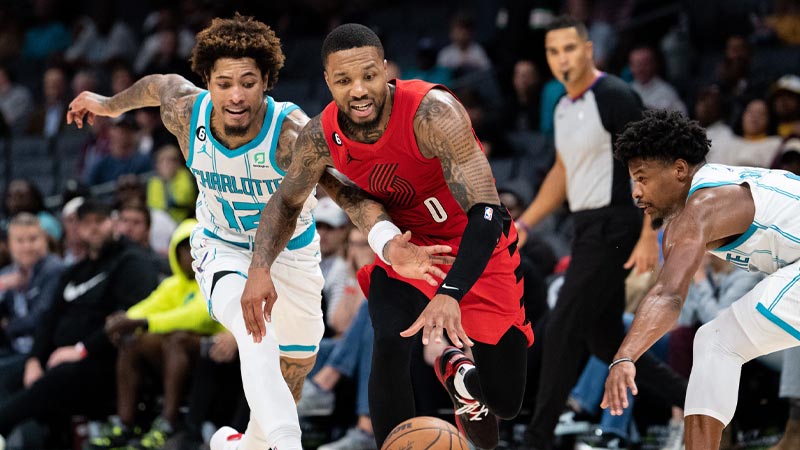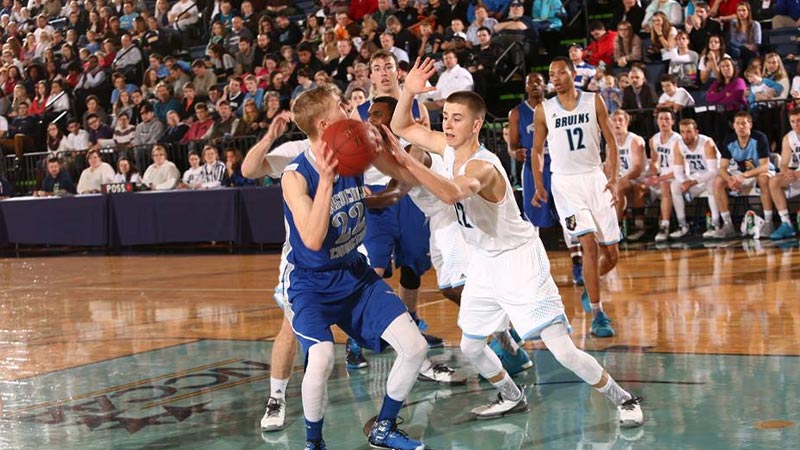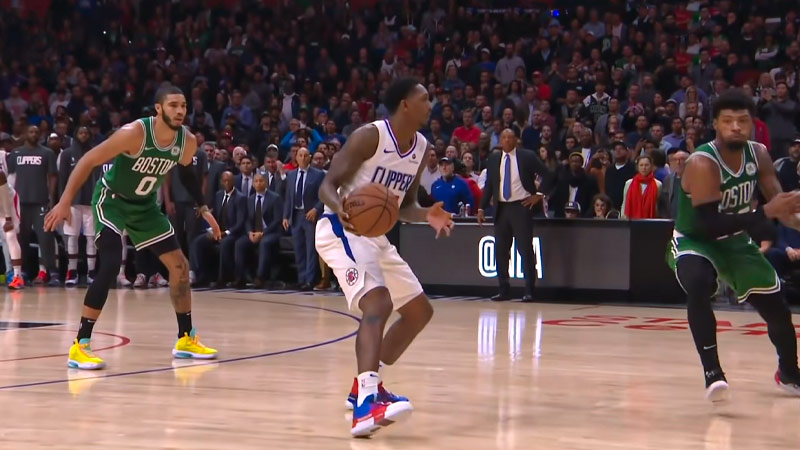In the fast-paced and competitive world of basketball, players are constantly looking for ways to gain an advantage and disrupt their opponents’ offense. One effective technique in this pursuit is deflection.
A deflection occurs when a defensive player manages to alter the path of a pass or disrupt an opponent’s dribble, leading to turnovers, disrupted plays, and potential scoring opportunities for their team.
In this blog post, we will explore the concept of deflections in basketball, discussing different types, how to create them, their impact on the game, and tips for successfully executing deflections. Stay focused.
What Is a Deflection in Basketball?
A deflection in basketball refers to the act of altering the trajectory of a pass or disrupting an opponent’s dribble. It is a defensive technique aimed at creating turnovers and disrupting offensive plays.
Deflections can significantly impact the outcome of a game, as they can lead to stolen balls, disrupted plays, and fast-break opportunities.
According to statistical data, deflections are closely tied to defensive success. NBA teams with higher deflection numbers tend to have better defensive ratings, indicating their ability to disrupt opponents’ offenses effectively.
Deflections require quick reflexes, active hands, and anticipation, making them a valuable skill for defensive players in basketball.
Different Types of Deflections

Source: nba.com
Deflections in basketball can occur in various forms, each with its own impact on the game. Let’s explore the different types of deflections and their significance:
Pass Deflections
Pass deflections happen when a defensive player manages to disrupt or intercept a pass. This can be achieved by getting a hand on the ball, altering its trajectory, or causing it to go out of bounds.
Pass deflections are valuable defensive plays as they disrupt the offensive flow, forcing turnovers and denying the opposing team scoring opportunities. They also create fast-break opportunities for the defensive team, allowing them to capitalize on the transition game.
Dribble Deflections
Dribble deflections occur when a defender successfully pokes the ball away or disrupts the dribble of an offensive player. This can lead to turnovers by forcing the offensive player to lose control of the ball or commit a violation.
Dribble deflections are particularly effective in creating rushed decisions from the offense, disrupting their intended plays, and providing opportunities for steals or fast-break opportunities for the defensive team.
Shot Deflections
Shot deflections happen when defenders manage to get a hand on a shot attempt, altering its trajectory or causing it to miss its mark. By disrupting the shooting rhythm of opponents, shot deflections can significantly impact the success rate of their shots.
They can force missed shots, alter the arc or angle of the shot, or even result in blocked shots, denying the offense potential scoring opportunities. Shot deflections put defensive pressure on the opposing team and contribute to a strong defensive presence.
These different types of deflections showcase the defensive skills and instincts of players. By mastering these techniques, defenders can actively disrupt the opponent’s passing, dribbling, and shooting, ultimately tilting the game in their team’s favor.
How to Create a Deflection in Basketball?

Source: coachwingreen.com
Creating a deflection requires a combination of anticipation, quick reactions, and defensive skills. Here are some techniques that can help you increase your chances of creating a deflection:
Active Hands and Arms
Keeping your hands and arms active and in passing lanes is crucial. By actively reaching and extending your arms, you increase the likelihood of disrupting passes.
This makes it more difficult for the offensive player to execute clean passes, potentially leading to deflections or turnovers.
Anticipate Passes
The opposing team’s offensive patterns and tendencies can give you an advantage in creating deflections. By studying their plays and player movements, you can anticipate where the pass is likely to go.
This allows you to position yourself strategically and be in a better position to intercept or deflect the pass.
Quick Hands
Developing quick hand-eye coordination is essential for creating deflections. The ability to react swiftly when a pass or dribble is within reach enables you to disrupt the offensive player’s control of the ball.
Practicing drills that focus on improving hand speed, agility, and hand-eye coordination will enhance your ability to create deflections.
Defensive Stance
Maintaining a low and balanced defensive stance is key to creating deflections. It allows you to move quickly and react to offensive movements.
By staying low, you are in a better position to react to the offensive player’s actions and make quick defensive movements.
This enables you to close passing lanes, deflect passes, and disrupt the offense effectively.
Communication and Teamwork
Effective communication with your teammates is essential in creating deflections. By communicating and coordinating with your teammates, you can anticipate passes together and work collectively to disrupt passing lanes.
This teamwork allows you to apply pressure on the offense and create chaos, increasing the chances of creating deflections.
By combining these techniques and continuously practicing them, you can improve your ability to create deflections in basketball.
Tips for Creating a Deflection
Implementing these tips into your defensive approach can significantly enhance your ability to create deflections in basketball.
Remember to be proactive, anticipate, and communicate with your teammates to disrupt passing lanes effectively.
Study Your Opponents’ Tendencies and Anticipate Their Moves
One effective way to create deflections is to study your opponents’ offensive tendencies. Pay attention to their passing patterns, preferred plays, and individual tendencies.
By understanding their style of play, you can anticipate their moves and position yourself strategically to disrupt their passes or dribbles.
Stay Active and Keep Your Hands and Arms in Passing Lanes
Remaining active on defense is crucial for creating deflections. Keep your hands and arms active, constantly moving them in passing lanes.
This active presence makes it more likely for you to get a hand on the ball and alter its trajectory, leading to deflections or even steals.
Develop Quick Hand-Eye Coordination and React Swiftly
Quick hand-eye coordination is essential for creating deflections. Work on drills and exercises that enhance your hand speed and agility.
Practice reacting swiftly to passes or dribbles, honing your ability to anticipate and react in real time. The faster your reactions, the greater your chances of getting a deflection.
Maintain a Low and Balanced Defensive Stance
A low and balanced defensive stance is crucial for creating deflections. Stay in a defensive position with your knees bent, weight-balanced, and body-centered.
This stance allows you to move quickly in any direction, making it easier to react to offensive movements and disrupt passes or dribbles.
Communicate with Teammates to Disrupt Passing Lanes Collectively
Effective communication with your teammates is key to disrupting passing lanes collectively. Coordinate with your teammates to position yourselves strategically, cutting off passing angles and pressuring the offense.
By communicating and working together, you can create a web of defensive pressure that makes it difficult for the offense to execute their plays and increases the chances of deflections.
With practice and focus, you can become a formidable defensive presence, consistently creating deflections and causing havoc for the opposing team’s offense.
How Deflection Affects a Basketball Match?
Deflections can have a significant impact on a basketball match. Here’s how they can influence the game:
Turnovers
Deflections often lead to turnovers, giving the defensive team possession of the ball. This not only denies the offense an opportunity to score but also provides a chance for the defense to transition into a fast-break situation.
Disrupted Plays
Deflections disrupt offensive plays, forcing the offense to regroup or abandon their intended strategy. This can lead to confusion and rushed decision-making, potentially resulting in missed scoring opportunities.
Defensive Momentum
Creating deflections can generate positive energy and momentum for the defensive team. It boosts morale, instills confidence, and can lead to an overall improvement in defensive performance.
Transition Opportunities
Deflections that result in turnovers often create transition opportunities for the defensive team. These fast-break situations can lead to quick and easy scoring chances, catching the opposing defense off guard.
Psychological Impact
Consistently creating deflections can frustrate the opposing team, disrupt their rhythm, and diminish their confidence. This psychological impact can tilt the balance of the game in favor of the defensive team.
FAQs
How can deflections help in disrupting offensive plays?
Deflections can disrupt offensive plays by altering the path of passes, forcing the offense to regroup, and potentially causing turnovers.
They create uncertainty and chaos, making it difficult for the offense to execute their intended strategy.
Can deflections lead to fast-break opportunities?
Yes, deflections often lead to fast-break opportunities for the defensive team. When a deflection results in a turnover, the defensive players can quickly transition to offense, catching the opposing team off guard and creating scoring chances.
Do deflections have an impact on the psychological aspect of the game?
Yes, deflections can have a psychological impact on the game. Consistently disrupting the offense, causing turnovers, and creating chaos can frustrate the opposing team, disrupt their rhythm, and decrease their confidence.
Are there specific positions or players more adept at creating deflections?
Creating deflections requires a combination of skills, such as anticipation, quick reactions, and defensive prowess.
While certain positions may naturally be more inclined toward creating deflections, any player can develop the necessary skills through practice and focus.
How can communication and teamwork help in creating deflections?
Effective communication and teamwork are vital in creating deflections. By coordinating with teammates, players can disrupt passing lanes collectively, anticipate offensive movements, and provide support to each other in creating deflections.
Bottom Line
Deflections are an essential defensive tool in basketball, enabling players to disrupt the offense, create turnovers, and generate scoring opportunities for their team.
By mastering the techniques of creating deflections and incorporating them into their defensive arsenal, players can become formidable defensive assets on the court.
Developing the skills of anticipation, quick reactions, and effective communication will elevate a player’s ability to create deflections.
So, embrace the art of deflection, disrupt your opponents’ game plan, and pave the way for your team’s success on the basketball court.







